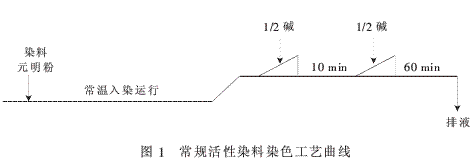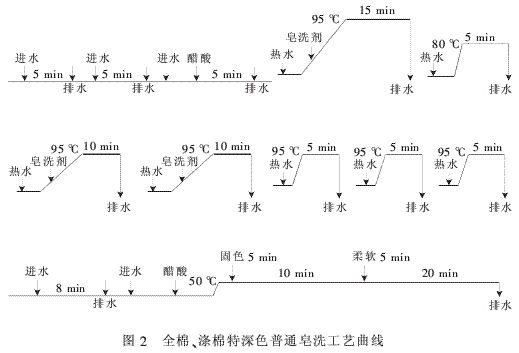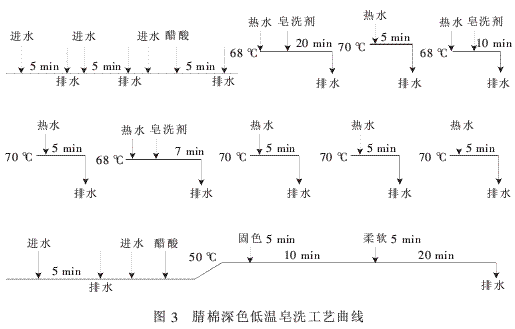Application of Reducing Agent SRC in Dyeing and Cleaning of Reactive Dyes Feng Xinji, Dong Qinxia, ​​Pan Yuming (Shanghai Bridge & Textile Yarn Co., Ltd., Shanghai 201114)
Abstract: The common cleaning method for cotton and its blended yarn fabric reactive dyes is to use a soaping agent to remove the floating color. Using the reducing agent SRC for cleaning test, based on the theory of destroying the floating color chromophore, it was found for the first time that the reducing agent SRC can be used in the cleaning after dyeing of reactive dyes. The optimal use amount is 1.0~1.5 g/L, and the bath is cleaned. The pH is 4.0~4.3, the temperature is controlled at 55~60°C, and the time is 5~10 min. The reducing agent SRC cleaning has no effect on the color of the cotton and its blended yarns, especially for the removal of the dark and special dark yarns or the surface of the fabric, and the color fastness is ensured. Compared with the conventional soaping agent process of reactive dyes, the reduction cleaning process is a new process with energy saving, water saving, time saving, labor saving, environmental protection and high efficiency.
Key words: reducing agent SRC; soaping agent; reactive dye; cleaning treatment; color fastness CLC number: TS 193.7 Document code: B Article ID: 1000-4033 (2012) 03-0022-03
With the improvement of living standards, people's requirements for quality of life are getting higher and higher. After cotton and its blended fabrics are widely used in various fields of textiles (such as sweaters, socks, etc.), people's quality requirements for textiles used in life, including the requirements for fastness, are gradually increasing.
At present, the commonly used cotton and its blended yarn or fabric dyeing process is: dyeing → water washing → neutralization → soaping → hot washing. The light color needs to be washed once; the middle color needs to be soaped once, and the hot wash is 2 times; the dark color needs high temperature soaping 2 times, hot washing 2 times; the special dark color needs high temperature soaping 3 times, high temperature hot washing 4 To meet the requirements of customers. Even so, sometimes the customer's requirements for color fastness are not met.
In today's energy-saving and emission-reducing, such time-consuming, water-consuming and power-consuming post-dye cleaning processes have been unable to meet the requirements of the times. Although some low-temperature soaping agents available on the market can meet the customer's requirements for fastness, the process still consumes time and power. Therefore, it is necessary to find a simple process that is energy-saving, environmentally friendly, and can guarantee various color fastness indicators.
Through a lot of research and bold attempts, we use the chromophores that destroy the color after dyeing as the theoretical basis, break through the traditional method, use the reducing agent SRC for the cleaning treatment after reactive dyeing, and carry out the soaping agent with other reactive dyes. Compared with the cleaning effect, it was found that the reducing agent SRC has a strong reducing ability, and can destroy the floating dye which is not decomposed or decomposed after being dyed at a lower temperature; and the cotton and its blended yarn or The washing fastness of the fabric after the cleaning agent SRC is cleaned is the same as that after the soaping agent is cleaned, especially for the removal of the dark and extra dark yarn or the surface of the fabric. Even the special dark yarn The wire or fabric can be cleaned and cleaned once at a low temperature, which can also meet the requirements of high standard customers for fastness, and has little effect on color.
The use of reducing agent SRC for cleaning treatment after reactive dyeing is simple, practical, energy-saving, water-saving, time-saving, labor-saving, environmentally friendly, and is a new process that can improve efficiency. Therefore, the reducing agent SRC is a good substitute for the soaping agent in the conventional dyeing process of reactive dyes.
1. Tests 1.1 Materials and instruments Materials: cotton, polyester cotton, nitrile cotton yarns (all are package yarns).
Dyes: active FGR black, active BF-3R yellow, active BF-3B red.
Additives: Reducing agent SRC (Yacco SRC), Neutral soaping agent SW (Yayun Company), low-temperature soaping agent WS dispersing agent (Ciba Company).
Equipment and instruments: Gao Xun GB241 dyeing cylinder, 722S visible spectrophotometer (Shanghai Guanguang Technology Co., Ltd.) and so on.
1.2 Staining prescription Black prescription:
Active FGR black 9.0%
Active BF-3R yellow 1.5%
Active BF-3B red 2.0%
Yuanming powder 100 g/L
Soda ash 25 g/L
Red prescription:
Active BF-3B red 4.00%
Active EC-GF Blue 0.05%
Active BF-3R Yellow 1.50%
Yuanming powder 100 g/L
Soda ash 25 g/L
The dyeing process conditions and process (taking the special dark color as an example) are shown in Figure 1. 
1.3 Ordinary soaping process 1.3.1 The specific process of ordinary soaping of cotton, polyester and cotton is shown in Figure 2. 
This process lasts for 4 h (including the influent and drainage time, excluding the solid color softening time); for special dark fabrics, it needs to be washed 3 times with high temperature, 4 times with high temperature water, and the total water consumption is about 12 cylinders. Auxiliary amount: The first soaping agent SW is 2 g/L; the second soaping agent SW is 1 g/L; and the third soaping agent SW is 1 g/L.
1.3.2 Nitrile cotton dark low temperature soaping The specific process is shown in Figure 3. 
The process lasts for 4 h 25 min (including the influent and drainage time); for dark fabrics, it needs 3 times of medium temperature soaping, 5 times of medium temperature water washing, and the total water consumption is about 13 cylinders.
1.4 Reducing agent SRC reduction cleaning process The specific process flow is shown in Figure 4. 
This process is generally used for 1.5 to 2.0 h (including the influent and drainage time); generally this process requires 1 medium temperature reduction cleaning, 2 times of water washing at a certain temperature, and the total water consumption is about 7 cylinders.
In the experiment, it was found that the dye residue in the dyeing tank was visually changed to a pale yellow color after the addition of the reducing agent SRC. Therefore, there is no possibility that the residual liquid will be smeared on the yarn, so that the number of times of washing after the reduction washing is ensured. In addition, since the reducing agent acts under acidic conditions, it does not function under near-neutral or weakly alkaline conditions, so that after the reduction washing and neutralization are completed, it is only necessary to wash the water to neutrality.
1.5 Test method 1.5.1 staining fastness according to the national standard GB/T 3921.3-1997 "Textile fastness test color fastness to wash: test 3 kinds of fiber fastness" determination, evaluation of staining Gray card rating.
1.5.2 Rubbing fastness According to the national standard GB/T 3920-1997 "Determination of the color fastness of textile color fastness test", the gray color rating of the discoloration is evaluated.
2. Results and discussion 2.1 Effect of the amount of reducing agent SRC on the reduction and cleaning effect of cotton yarn The cotton yarn package yarn was dyed according to the dye prescription described in 1.2. After the dyeing was completed, different amounts of reducing agent SRC were added for cleaning.
Practice has found that no matter which color, the dyed foot water in the dyeing tank becomes pale yellow immediately after adding the reducing agent SRC, but the color change of the foot water is not obvious with the increase of the dosage. The optimum amount of reducing agent SRC was determined by testing to be 1.0 to 1.5 g/L.
In addition, it has been found that the reduction cleaning of the reducing agent SRC can effectively remove the floating color of the yarn surface, and has an obvious effect on improving the yarn fastness. When the dosage is about 1.0~1.5 g/L, after using the reducing agent SRC for reduction and cleaning under low temperature conditions, the requirements of the yarn color fastness can be achieved, and the color of the cotton yarn is not affected.
2.2 Effect of pH value on the reduction and cleaning effect of cotton yarn The reducing agent SRC is active under acidic conditions and does not work under near-neutral or weakly alkaline conditions. Therefore, reasonable control of pH value has effect on reduction cleaning. Great impact.
It has been found in practice that as the pH value decreases, the cleaning action of the reducing agent SRC is strengthened, and the strength of destroying the floating dye is enhanced. Since the floating dye is changed from colored to light color, strictly speaking, the chromophore of the floating dye is destroyed to ensure the color fastness index requirements of the yarn. The data shows that in the process of using the reducing agent SRC, the pH value of the cleaning bath must be controlled to 4.0 to 4.3, in order to effectively ensure the effective strength of the reduction cleaning.
2.3 Influence of temperature and time on the reduction and cleaning effect of cotton yarn In order to meet the color requirements and meet the various color fastness requirements of customers, the use temperature and action time of the reducing agent SRC must be strictly controlled. Under normal circumstances, as the temperature increases, the reduction is enhanced; however, if the temperature is not properly controlled, the dyeing residue in the dye liquor is destroyed, and the dye and the fixed dye may be destroyed. Therefore, it must be strictly controlled. Restore the temperature and time of the wash. Practice has found that the temperature is controlled at 55-60 ° C, and the time is controlled at 5-10 min.
3. Production practice According to the process described in 1.2, the 1500 kg cotton yarn of the yarn dyeing workshop is dyed separately. After the dyeing is completed, the cotton special dark soap cleaning process and 1.4 are respectively described in 1.3.1. The reducing agent SRC reduction cleaning process was post-treated and tested according to the test standard described in 1.5.
It has been found that, regardless of the color, after the fabric is treated according to the procedure described in 1.4, the color fastness of the fabric can completely reach the color fastness comparable to the ordinary soaping process described in 1.3.1; The reduction cleaning process can reduce the total process time by 1.5 to 2.0 h.
According to the same method, other color comparison experiments show that for the processing of medium and dark colors, from pre-cylinder treatment, dyeing to reduction cleaning, the whole time can be controlled within 7 h, which significantly reduces the process time and achieves energy saving. The role of cost reduction and efficiency increase provides technical support and market space for corporate profits.
4. Conclusions 4.1 Reducing agent SRC can effectively remove and destroy unfixed reactive dyes on cotton and its blended yarns, and has no effect on shade and color fastness. The dosage can be 1.0-1.5 g/L. A better cleaning effect is obtained.
4.2 In the process of using the reducing agent SRC, the pH value of the cleaning bath must be controlled at 4.0 to 4.3 to ensure the effective strength of the reduction cleaning.
4.3 Strict control of reducing agent SRC reduction cleaning temperature is 55 ~ 60 ° C, time is 5 ~ 10min, to avoid damage to the yarn and the fixed dye.
4.4 The application process of reducing agent SRC in the cleaning treatment after reactive dyeing has been widely used in the dyeing process of reactive dyes of our company's cotton and its blended yarns. The characteristics of the process are: simple process, short processing time, reduced amount of additives, achieving the functions of water saving, electricity saving, coal saving, time saving, and comprehensive cost reduction, which has obtained great economic benefits for the company. Good market prospects.
4.5 Because the production environment of each enterprise is different; the dyeing materials and additives used are different; the process conditions and process flow will be different. Therefore, any good process and good method must go through many pioneering research, discussion, small sample, medium sample and magnified sample test, find out the best technological route and technological breakthrough suitable for your own enterprise, and must not directly copy it. Photo set.
Rutile Titanium Dioxide,Titanium Dioxide Rutile,Titanium Dioxide Anatase
Raw Materials,PVC Additives Co., Ltd. , http://www.chpvcadditives.com